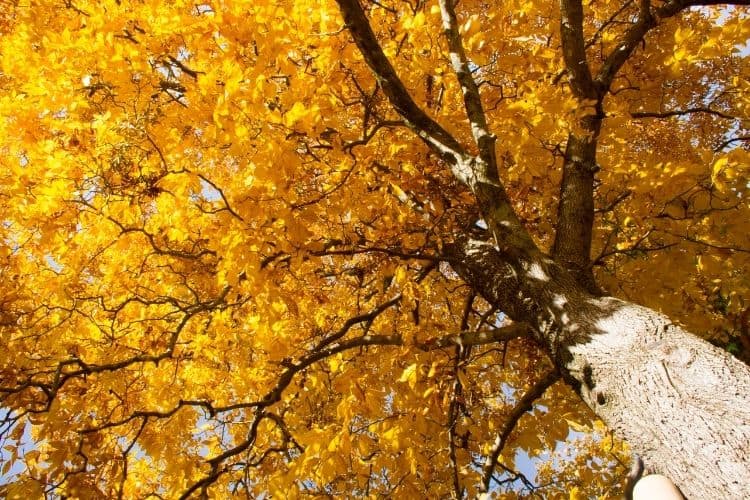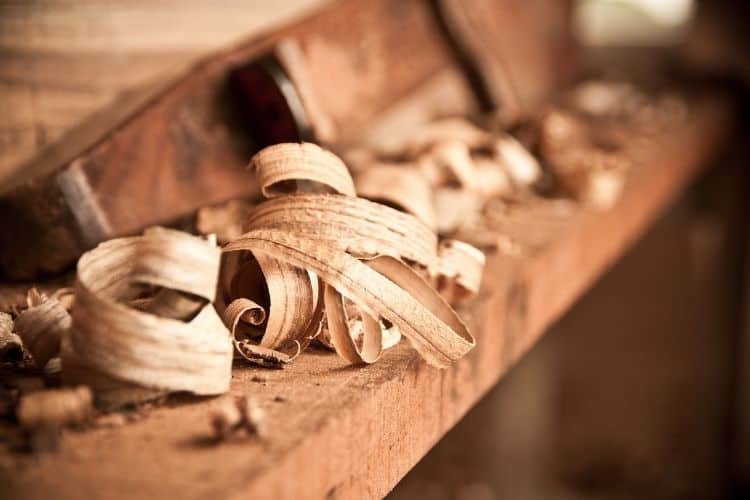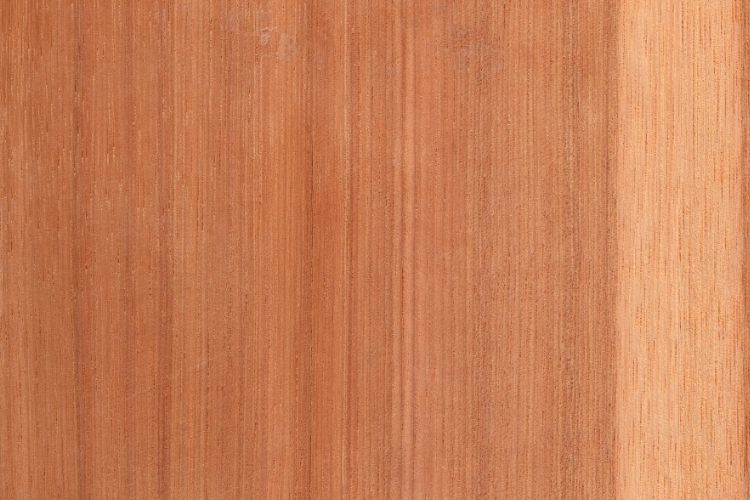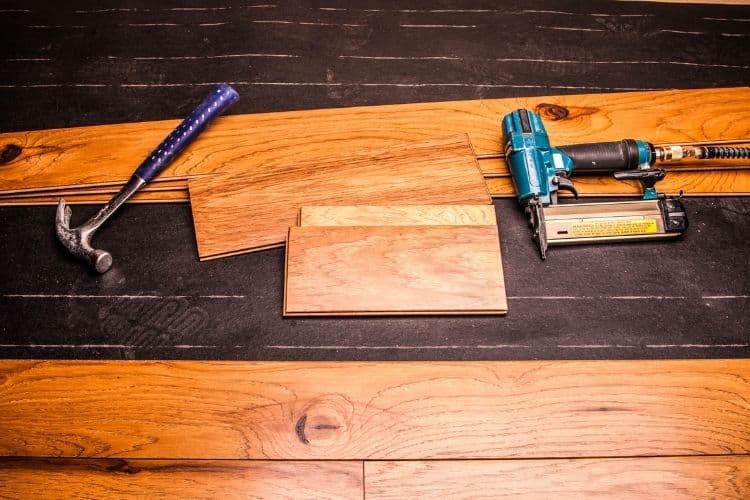- Lumber Guide: Pignut Hickory Wood Uses - April 28, 2022
Pignut hickory, Carya glabra, is a durable, strong, and highly flexible wood. Few other kinds of timber compare in these respects. Also, pignut hickory is a highly versatile wood in terms of usage. The wood is valuable in manufacturing, home improvement, and cooking.
Hickory has long been part of the North American experience. Colonists used it for fuel, wagon wheels, and brooms.
General Andrew Jackson was nicknamed Old Hickory by his soldiers because of his fierce and uncompromising fighting in the Battle of New Orleans in 1815. In his home state of Tennessee, this wood had already gained prominence for its toughness and durability, qualities his soldiers saw in him.
The Choctaws of the lower Mississippi River Valley used hickory for bows and baskets. Also, they creatively used hickory sap for sweet syrup and sugar.
American pioneer Davy Crockett valued hickory as for firewood. Consider this astonishing fact – hickory produces 24 million Btus per cord, which is about the same as 200 gallons (757 liters) of number 2 fuel oil.
You probably have come across this wood in one form or another. There are many Pignut Hickory wood uses, including furniture, flooring, tool handles, firewood, meat flavoring, and sporting goods.
Botanical Characteristics

Before getting into the woodworking information, look below at some short botanical aspects of this tree. This information will help you get a complete understanding of this strong and valuable wood.
Pignut hickory, Carya glabra, belongs to the Juglandaceae botanically family. This family is commonly referred to as the walnut family. But don’t get too excited – the pignut hickory nuts are very bitter.
Distribution
Pignut hickory is native to nearly all of the eastern United States and the southernmost areas of Ontario, Canada. It grows naturally from Central Florida northward to Massachusetts; and as far west as Missouri down to Louisiana.
Tree Size
Pignut hickory is a deciduous and slow-growing tree that gets to be 50 to 60 feet (15 to 18 meters) with a 25 to 35 feet spread (7.62 to 10.67 meters). In the wild, this tree can get up to 100 feet tall (30.48 meters). It has a straight trunk, and the branches are sometimes close to the ground.
Leaf
You can identify this tree quickly by its compound leaves.
They are alternative, feather-compound, 8 to 12 inches long (20.32 to 30.48 centimeters). Each “leaf” usually comes in leaflets of 5 or 7 on a rare occasion.
The leaflets are lance-shaped, narrow at the base or middle, margin toothed, and tip tapered to a point. The upper surface of the leaflets is yellow-green and smooth. Under the surface, they are paler, smooth, and hairy along the veins.
One distinguishing feature that you may enjoy from this tree is the bright yellow color of the leaves in the fall.
Bark
The bark of the pignut hickory is gray, thin, light, tight, and rough. Overall, the bark has crisscrossing cracks forming close, flattened scales.
Twigs
The twigs are slender, smooth, and reddish-brown.
Flowers
The male and female flowers are separate but on the same tree. The flowers appear as drooping catkins (spike-shaped flowers).
They appear after the leaves are out. Flowering timing depends on the geographic location of the tree. Generally, it will flower in the springtime, depending on your geographic location. It can bloom as early as February or March in the deep south and as late as May further north.
Fruit
The fruits of Pignut hickory are egg-shaped and about ½ to 1 ¼ inch long (1.27 to 3.18 centimeters). Fruits appear in the late summer or early fall. The outer husk is dark brown, thin, and splitting. While this tree belongs to the Walnut family, you are unlikely to like it as it has an unpleasant taste.
Woodworking Characteristics

The Hickory family is one of the hardest and strongest woods native to the United States. Compared to white oak or hard maple, hickories are denser, harder, and stiffer.
Color/Appearance
The heartwood of Pignut hickory tends to be light to medium brown with a distinctive reddish hue. The sapwood has a paler yellowish-brown color. This beautiful contrast of the heartwood and sapwood together can create a rustic appearance. This look is marketed as Calico Hickory.
Grain/Texture
Pignut hickory wood grain is generally straight with occasional waves and a medium texture. The wood’s pores are medium in size and open.
Rot Resistance
Unfortunately, rot and insect resistance are some of the weaker features of pignut hickory wood. The wood is considered to be non-durable to heartwood decay. Also, be careful as it is very susceptible to insect attack.
Workability
Pignut hickory is hard to work. Tear-outs are common during machining operations if cutting edges are not sharp. Be careful to maintain your cutting edges, as this wood tends to blunt them. So expect to be sharpening your edges very often if you have a big project using this wood.
Restore the blade to its prime glory within minutes with Sharp Pebble Ax Sharpener Stone. Made with premium quality 100% silicon carbide and 40% larger surface area it provides an exceptionally sharp blade with minimal effort.
Durability

The Janka hardness measurement is one of the most efficient ways to determine the durability of any hardwood species. It measures how well the wood will withstand dents, dings, and tears. But it also indirectly predicts the difficulty the woodworker will have in nailing, screwing, sanding, or sawing.
The scale ranges from zero upwards in terms of toughness and is measured in pounds-force. Closer to zero, the wood is too soft to work with, but you can assume that working with the given wood species is difficult.
Pignut hickory scores 2,140, which is relatively harder than white oak (1,350) and slightly more rigid than the related pecan wood (1,820). As such, it is more durable than Pecan wood but more challenging for working.
Odor
Pignut hickory wood has no characteristic odor.
Allergies/Toxicity
Be careful when handling any wood dust as it may harm your respiratory health. Besides this risk factor, no particular allergies or toxins are associated with handling or using Pignut Hickory.
Pricing/Availability
In most cases, on the wood market, various species of hickory and Pecan (Carya illinoinensis) are mixed and sold as “Hickory.” You will tell if there is Pecan mixed in because it has a more pinkish tone.
Be aware that this tone could alter staining and finishing results when mixed with tan-colored hickories in the same project. So, to be safe – try to sort them out.
Pignut hickory is not an expensive wood, and you should expect prices to be in the low to mid-range; naturally, this depends on local availability. The prices should not be much different from Red Oak or Soft Maple, which have similar utility.
Pignut hickory is abundant in the eastern United States forests; for this reason, the price can be as low as $1.50 (US Dollars) per board foot.
Common Uses

Besides being a formidable forest tree, pignut hickory gets much of its attention from the utility of its timber.
Traditionally hickory has been the wood of choice for objects that need abuse-resistant and strong wood. Wherever strength or shock resistance is necessary, pignut hickory wood is highly recommended.
Really, for any tool or object that gets a daily pounding – hickory is the best bet.
Tools
Pignut hickory has long had a place in tool manufacturing. This continues to be the case today. The characteristics of the wood make it an unparallel fit for the tool manufacturing industry.
As tools are used daily, they need to be made from very resilient wood. Also, it is crucial that users can rely on the quality of the handles of their tools for their safety. This is why the strength and durability of pignut hickory make it great for any tool handles, shovels, ladder rungs, and wheel spokes.
Pignut hickory wooden handles will flex slightly without breaking, which makes the tools easier to use. For example, an ax handle will absorb some of the shocks as the ax head splits wood. This construction translates to less impact on the hands and arms of the user.
Sporting Goods
Pignut hickory was a wood choice for manufacturing sports goods because of its durability and strength. Examples include tennis rackets, bows, skis, fishing rods, lacrosse shafts, and hockey sticks.
Cabinets, Flooring, and Furniture
Naturally, everyone has different tastes in wood aesthetics. Some people swear by a particular type of wood look, while others find it ugly. For those who like a rustic look, pignut hickory is a good choice. It has sharply contrasting wood colors, which may be the rustic touch that some home and cabin owners want to experience.
Before the 1990s, many people did not like using hickory inside the home because of the contrasting colors. But today, pignut hickory furniture, flooring, and cabinets are popular. This change goes to show how style preferences evolve and change.
Firewood and Seasoning
Having a very high energy content, pignut hickory is a useful and commonly used firewood. You can use it to fuel your wood-burning stoves and chimineas.
The smoke of pignut hickory wood is distinctive and pleasant. The wood has long been used in North America for smoking and curing meats such as ham, bacon, and fish.
Today, larger producers use other methods and artificial flavorings to get the hickory-smoked flavor. But, smaller traditional meat suppliers still use pignut hickory wood to give smoked meat the definitive hickory flavor.
If you want to enjoy this flavor at home, you can buy hickory chips for your barbecue grill. They are found online and in many stores, especially in the eastern half of the United States.
Tips on Handling Pignut Hickory

Given that Pignut hickory has an extremely high level of hardiness – your power tools will need carbide-tipped blades and cutters. Naturally, it would help if you are careful when handling; here are some additional tips:
- Feeding the wood – Feed the wood at a slight angle; this will help to avoid surface chipping.
- Ripping – When ripping, feed the hickory slowly. Doing this allows the blade plenty of time to clear itself of sawdust. But, if you crosscut with a carbide blade, there should be no problems.
- Jointing – If the stock is straight-grained, it should be easy to joint. But take lighter cuts for occasional wavy-figured wood as it could easily chip.
- Steam-bending – To do this, use the straightest-grained stock and ensure that you do so slightly tighter than needed when you make arcs. Then, for an exact fit, pull the arch wider.
- Drilling – When drilling, use only spurred bits and slower drill-press speeds. Suppose the stock is thick; clear the bit often to avoid burnishing.
Brushless motor of cordless drill combo kit delivers up to 57% more runtime over brushed. XR Lithium Ion batteries with fuel gauge in cordless tools combo kit provide 33% more capacity over standard packs.
- Avoiding tear-out – With a consistent feed rate, take light routing passes.
- Avoid cross-grain sanding – Avoid doing this because it causes scratches on the wood. Wherever grains meet at right angles, use a metal cabinet scraper or random-orbit sander to cleanup.
This Brushless Cordless Random Orbital Sander provides the power and runtime needed to get the job done. A variable-speed dial provides ultimate speed control from 8,000 to 12,000 OPM for a variety of projects.
- Gluing – For best results, use an adhesive with a longer open time. A good example is a white glue. Lay a light coat of glue, join the pieces briefly, and gently pull them apart to allow the glue to set partially before reassembling them.
High performance industrial grade adhesive. Starbond Black Medium Thick CA is used to bond parts, with focus on impact and shock absorbance qualities.
- Fasteners – Always drill pilot holes for them because the wood may split.
- Finishing – Fill the grain to achieve ultimate smoothness. Also, note that pignut hickory responds to all stains and finishes well and can be quite beautiful.
(FAQs) Frequently Asked Questions
Question: Can I Use Pignut Hickory as Firewood?
Answer: Pignut hickory makes excellent firewood. This is because of its very high energy content. Consider using it in your chimney or wood-burning stove; you will not be disappointed.
Question: Do I Have to Worry About Any Allergies when Working Pignut Hickory?
Answer: No, this wood is not known to cause any allergies. However, be careful with the sawdust, as any sawdust may cause some respiratory irritation.
Question: Do I Need Powerful Tools for Working Pignut Hickory?
Answer: Pignut hickory is tough as nails! This is a relatively difficult wood to work, so the stronger and sharper your tools are, the easier it will be to work this wood. Also, using poor-quality tools may damage the wood and increase the risk of injury.
So, try to use the strongest and sharpest tools you have, and take some time to carefully read tips on handling the wood.
Question: I Know Pignut Hickory is Related to Walnuts and Pecans. Can I Eat the Nuts?
Answer: Pignut hickory nuts are bitter. You are unlikely to enjoy the taste. Perhaps, it is better to avoid it. Stick to walnuts and pecans; pignut hickory will disappoint you.
Question: Where Can I Buy Pignut Hickory Wood?
Answer: You probably can find this in every lumberyard in the eastern half of North America. This fact is because the tree is so abundant in the forests of that region.
However, it may not always be labeled as pignut hickory and can just be labeled as hickory. If you are adamant about only getting pignut hickory, consult with a reputable wood supplier in your local area.
Final Thoughts
Pignut hickory has some excellent characteristics and uses. While it is tough as nails, it is highly flexible and versatile. Furthermore, this wood is inexpensive because it is plentiful in North American forests. If you are looking for a rustic aesthetic on a budget, consider using it for your next woodworking project.
References





